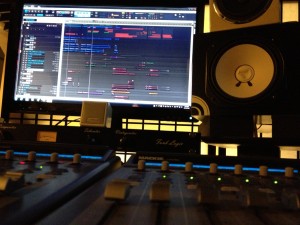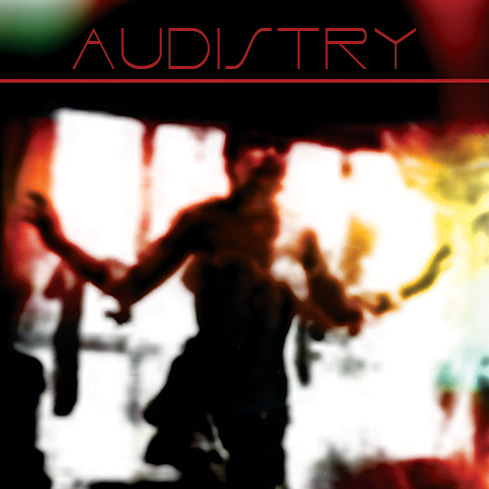 Audistry is the 2012 full-length album release fusing film/TV composer Shawn K Clement’s deep Other-Worldly cinematic orchestral music and signature guitar sound, with my Audnoyz genre-mashing production aesthetic.
Audistry is the 2012 full-length album release fusing film/TV composer Shawn K Clement’s deep Other-Worldly cinematic orchestral music and signature guitar sound, with my Audnoyz genre-mashing production aesthetic.
Audistry epitomizes how collaborative work is happening these days out of home studios. In this case a bicoastal collaboration with tracks bouncing back and forth between  Clemistry Ranch, North of Los Angeles and a personal studio outside of Boston, where the final slicing, dicing, mixing, and mangling was done December 2012.
Clemistry Ranch, North of Los Angeles and a personal studio outside of Boston, where the final slicing, dicing, mixing, and mangling was done December 2012.
WTF like many of the tracks on the Album is an assemblage of material from past projects taken out of their original contexts  blended with new material, united in a form that tells a story.
blended with new material, united in a form that tells a story.
WTF started with Shawn digging up a dense orchestral cue that I then stripped down to just the tuba and contra bassoon pairing, added a trombone, and then laid that on top of a drum track played by Frank Basile of LiveStudioDrums.  The thing is Shawn’s original orchestral stems were in multiple time signatures so I basically sliced, diced, and aligned the voicing on top of Frank’s solid 4/4 beat. Franks simple set up for recording the drums kick: Audix D4, snare: SM57, toms: Sennheiser e603s, hats: Audio Technica ATM11R, overheads: paired Audio Technica 4033s into a PreSonus StudioLive 24 board front end to Sonar.
The thing is Shawn’s original orchestral stems were in multiple time signatures so I basically sliced, diced, and aligned the voicing on top of Frank’s solid 4/4 beat. Franks simple set up for recording the drums kick: Audix D4, snare: SM57, toms: Sennheiser e603s, hats: Audio Technica ATM11R, overheads: paired Audio Technica 4033s into a PreSonus StudioLive 24 board front end to Sonar.
My goto plug-ins on WTF for achieving that analog-tape sound is the UAD-2 Studer 800 that not only provides “that sound of tape” but also  provides a great EQ tool. Depending on what I am going for I’ll tweak the HF setting in the Studer rather than mess with the channel EQ, always netting a pleasant outcome. And, the Empirical Labs Fatso Jr. emulation that’s just awesome for sculpting harmonic content. The more you hit it with input level the more second and third-order harmonics are added to the signal. It’s just great
provides a great EQ tool. Depending on what I am going for I’ll tweak the HF setting in the Studer rather than mess with the channel EQ, always netting a pleasant outcome. And, the Empirical Labs Fatso Jr. emulation that’s just awesome for sculpting harmonic content. The more you hit it with input level the more second and third-order harmonics are added to the signal. It’s just great  for fattening up and spreading out. Both of these plugs were used on the drums, harmonica, and are the secret to getting the phat bass with no bass guitar or synth in use on the main theme section. Next I put together the transitional elements from another of Shawn’s orchestral cues, along with a track from my catalog and the basic arrangement took shape.
for fattening up and spreading out. Both of these plugs were used on the drums, harmonica, and are the secret to getting the phat bass with no bass guitar or synth in use on the main theme section. Next I put together the transitional elements from another of Shawn’s orchestral cues, along with a track from my catalog and the basic arrangement took shape.
The arrangement was then packed up and sent to Canyon Country via the Clemistry FTP. Shawn then got to tracking the heavy guitars at Clemistry with the help of his long-time assistant, engineer James Speight.  With the multiple mike parings and different guitar takes we ended up with 50+ guitar tracks to work with for the Mix.
With the multiple mike parings and different guitar takes we ended up with 50+ guitar tracks to work with for the Mix.  Guitars used in the tracking were a 1952 Les Paul Gold Top, custom made Stephens, Yamaha Pacifica 604, and a1960
Guitars used in the tracking were a 1952 Les Paul Gold Top, custom made Stephens, Yamaha Pacifica 604, and a1960  Dan Electro, all into a Marshal Plexi 100. An assortment of pedals were used, including Pigtronix
Dan Electro, all into a Marshal Plexi 100. An assortment of pedals were used, including Pigtronix  (the mothership, tremvelope, philosopher king), as well as distortion boxes from Coffin Cases
(the mothership, tremvelope, philosopher king), as well as distortion boxes from Coffin Cases  and Vicious Monkey. The Marshall cab was mic’d using a Roland binaural head placed 5’ behind the cab, one SM57 placed in front 6 inches from the cone another SM57 in back of the cab, and Blue Dragon Fly in front positioned 4’ feet back and high.
and Vicious Monkey. The Marshall cab was mic’d using a Roland binaural head placed 5’ behind the cab, one SM57 placed in front 6 inches from the cone another SM57 in back of the cab, and Blue Dragon Fly in front positioned 4’ feet back and high.  Also used was an AKG 414 on a Portuguese guitar placed in front of the cab to pick up just resonance, Shawn likes to play loud! All straight into the Yamaha 02Rs, of which Clemistry has three. Also, Kellie Rucker’s kik-ass Harmonica was
Also used was an AKG 414 on a Portuguese guitar placed in front of the cab to pick up just resonance, Shawn likes to play loud! All straight into the Yamaha 02Rs, of which Clemistry has three. Also, Kellie Rucker’s kik-ass Harmonica was  recorded on this session using a hand held bullet mic straight into a 66’ Fender Champ with Kellie getting the feedback effect by putting her face right into the amp.
recorded on this session using a hand held bullet mic straight into a 66’ Fender Champ with Kellie getting the feedback effect by putting her face right into the amp.
The track then came back to New England for layers of Audness,  ethereal textures from Omnisphere, and Native Instruments Massive and Absynth; lots of guitar comp editing, tweaking and mixed by both of us in the same room. We stacked up 25 busses with a Studer 800 strapped on all but a few.
ethereal textures from Omnisphere, and Native Instruments Massive and Absynth; lots of guitar comp editing, tweaking and mixed by both of us in the same room. We stacked up 25 busses with a Studer 800 strapped on all but a few.  The very fine SSL Bus emulation in Sonar’s Pro Channel, Stillwell Bombardier,
The very fine SSL Bus emulation in Sonar’s Pro Channel, Stillwell Bombardier,  and UAD-2: LA2A, LA3A, Fatso Jr, and Precision Limiter keeping things in place. Five busses for FX that included Perfect Space convolution reverb, Sonitus FX Delay, Softtube, passive and focusing EQs; UAD-2 EMT Plate 140 and Lexicon 224 digital reverbs which are great for depth and the
and UAD-2: LA2A, LA3A, Fatso Jr, and Precision Limiter keeping things in place. Five busses for FX that included Perfect Space convolution reverb, Sonitus FX Delay, Softtube, passive and focusing EQs; UAD-2 EMT Plate 140 and Lexicon 224 digital reverbs which are great for depth and the  CSI
CSI multi fx processor, that I fell in love with years back as it came standard on the original UAD-1 cards. With all the horse power we had on the 32GBRAM/8 Core/ i7 screamer audio system running verbs on a gazillion tracks is not an issue. However, I find tracks sharing reflections of the same reverb brings things more together. The fact is many a classic gold record has been made with just a couple of plate or spring reverbs.
multi fx processor, that I fell in love with years back as it came standard on the original UAD-1 cards. With all the horse power we had on the 32GBRAM/8 Core/ i7 screamer audio system running verbs on a gazillion tracks is not an issue. However, I find tracks sharing reflections of the same reverb brings things more together. The fact is many a classic gold record has been made with just a couple of plate or spring reverbs.
At the end of the day, WTF like all the Audistry tracks happened organically. We had no creative direction by an outside production, no deadlines; it was just us having fun. The most exciting part is seeing how un-related music can be linked together, and evolves beyond itself. Also, how with the right tools you can create a performance-like track via a composite process in home studios that sounds good. In a future article I’ll cover the final mastering of Audistry.

